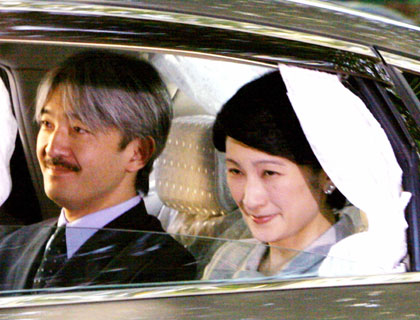It's been the focus of intense speculation for months: will Japan's Princess
Kiko forestall a succession crisis for the ancient Chrysanthemum Throne by
giving birth to the family's first male heir in 40 years?
|

Japanese Princess Kiko (R),
accompanied by her husband Prince Akishino (L), the second son of Emperor
Akihito, arrive at Tokyo's Aiiku Hospital August 16, 2006.
[Reuters] |
The government on Friday set a date for an answer, announcing that
39-year-old Kiko _ the wife of Emperor Akihito's second son, Prince Akishino _
will have a Caesarean section on September 6.
The gender of the baby has not been announced, but it's widely felt that the
birth of a boy would take the urgency out of a stalled debate over whether to
change Japan's male-only succession law to allow a woman to take the throne.
Kiko was hospitalized on August 16 in expectation of the surgery to have her
third child. Doctors say she is in good health, but with symptoms of partial
placenta previa, in which part of the placenta drops too low in the uterus.
Yuka Shiina, an agency spokeswoman, said the operation would take place
Wednesday morning, but refused to provide any further details. A male baby would
be third in line to the throne, after Crown Prince Naruhito and Akishino.
Potential emperors are in short supply these days in Japan.
The last potential male heir born was Akishino himself, in 1965. Naruhito has
had a daughter with his wife Masako, but the couple have no sons, meaning there
is no one to inherit the throne after he and his brother are gone. Kiko,
likewise, has no sons.
Japan's 1947 succession law limits sitting monarchs to male descendants of an
emperor, meaning Naruhito's 4-year-old daughter, Aiko, is ineligible to take
over.
The looming succession crunch had prompted serious discussion of changing the
law to allow a female to assume the throne. The proposal had the support of
Prime Minister Junichiro Koizumi and a majority of the public.
Even before the 1947 law, reigning empresses were rare, usually serving as
stand-ins for a few years until a suitable male can be installed. The last
reigning empress was Gosakuramachi, who assumed the throne in 1763.
Debate over the succession law was divisive and emotional. Some conservatives
proposed a revival of concubines to produce imperial heirs, and others argued
that allowing a woman on the throne would destroy a precious Japanese tradition.
News of Kiko's pregnancy _ and the possibility of a male heir _ in February
quickly put an end to the discussions.
Isao Tokoro, an imperial system expert at Kyoto Sangyo University, said even
if Kiko has a boy, it would only delay an eventual reckoning.
"If a boy is born, it will be easier to carry out a calm debate on what
should be done beyond 10, 20, and 30 years into the future," he said. "But if a
girl is born, then the debate will be rekindled immediately."
Royal watchers have little hope that Naruhito and Masako will have more
children. Beside the 42-year-old crown princess' age, she also suffers from
stress-induced depression and rarely appears in public.
The family recently went on vacation to the Netherlands on a trip that was
billed as a chance for Masako to rest quietly. The three royals were accompanied
by her chief doctor, Yutaka Ono.
Shielded by the obsessively secretive Imperial Household Agency, the gender
of Kiko's fetus has been a matter of national speculation, with publications
foraging for meager scraps of information that could provide clues.
Shukan Bunshun, a weekly magazine, this week published a story speculating
the baby was a boy. The evidence: an anonymous acquaintance of Akishino quoting
the prince as saying, "It looks that way," when asked if the fetus was a male.
The story concluded with the same anonymous source speculating that the
prince's comments were so vague that it was hard to draw a conclusion.